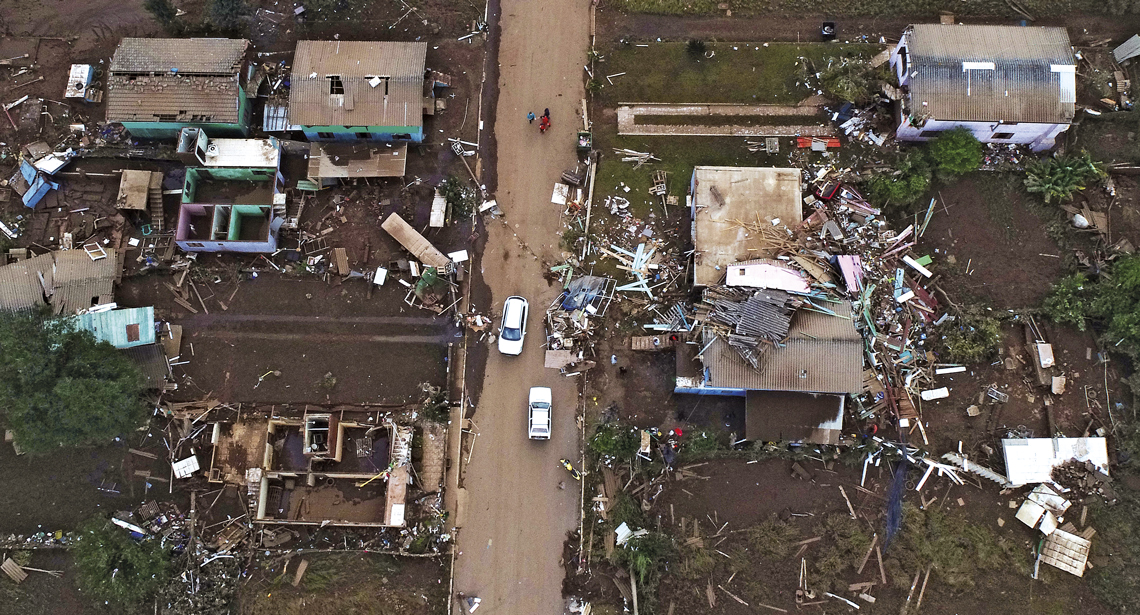Over the first five days of September, the central region of Rio Grande do Sul, southern Brazil, was battered by 300 millimeters (mm) of relentless rainfall, nearly double the average amount of precipitation in the entire month. The extreme rainfall, coupled with hail and wind gusts reaching up to 100 kilometers per hour, left a path of devastation across approximately 90 municipalities in the state. Around 4,700 people lost their homes, and another 20,500 had to temporarily evacuate their homes for shelter. Tragically, more than 50 people lost their lives and 900 sustained injuries due to landslides and floods caused by overspilling rivers, such as the Taquari, approximately 120 kilometers northwest of Porto Alegre. This was the worst natural disaster in the state’s recorded history.
The tragedy was caused by an extratropical cyclone, a designation given to large rotating weather systems that occur globally between 30 and 60 degrees latitude, outside the tropics, with wind speeds that are somewhat weaker yet similar in strength to a hurricane. Extratropical cyclones are formed when, in meteorological terms, a frontal system emerges—a frontal system is the convergence of two air masses with different densities and temperatures, one cold and the other warm.
This meteorological phenomenon is relatively commonplace in Brazil’s South and can result in anything from mild rain to devastating storms, as seen in September in Rio Grande do Sul. Locals there are no strangers to severe extratropical cyclones. In June, over 40 cities in the northern part of the state had already felt the impact of another storm of similar magnitude.
The increasing severity of extratropical cyclones on the continent may be influenced by the temperature differential between the land surface and the oceans, particularly during the winter. In this season, the continent cools more rapidly than the oceans, which act as heat sinks.
“In addition, the air over the South American continent tends to be drier than that over the Atlantic. As it moves toward the ocean, the dry and cold continental air absorbs heat and moisture from the sea. The temperature contrast between the air and the sea, combined with the low relative humidity of the air, further induces evaporation from the Atlantic, pulling more moisture and heat into the atmosphere,” explains Manoel Alonso Gan, a meteorologist at the Brazilian National Institute for Space Research (INPE). In the upper layers of the atmosphere, the vapor undergoes a phase transition to the liquid state. Just like evaporating water draws heat from a person wearing a wet shirt, the liquefaction of vapor conversely generates heat, injecting more energy into the cyclone.
There are no conclusive studies on whether extratropical cyclones are becoming more frequent or severe. While consensus is lacking, some research suggests that global warming might be causing the overall frequency of storms to diminish, while increasing the number of severe storms. “Global numerical analyses indicate a reduction in the overall number of cyclones over the years. But when they do happen, they’re more destructive,” explains Gan. In South America, extratropical cyclones typically form along the coastline from southern Argentina to Rio de Janeiro.
André Nunes, a meteorologist at the Federal University of Pelotas (UFPel), remarks: “As low-pressure centers—meaning they have less air than their surroundings—cyclones are closely linked to atmospheric instability. Seeking equilibrium, the atmospheric system causes air to converge towards the low-pressure center.”
In the Southern Hemisphere, cyclones rotate clockwise, while in the Northern Hemisphere they rotate counterclockwise. This is due to what is known as the Coriolis effect, which pushes poleward winds west, and those blowing in the opposite direction east.
Low-pressure systems form over continents fairly frequently, but not necessarily as extratropical cyclones. These typically emerge over oceans, where water evaporation is significantly higher. Nunes adds: “Warm sea currents from northeastern Brazil often converge with cold currents coming from the Falkland Islands off the coast of Rio Grande do Sul, meaning cyclones tend to occur more frequently in this area of Brazil’s South.”
Extratropical cyclones have a warm sector in their eastern portion—the point of entry of the higher-temperature air mass—and a cold sector to the west, influenced by cold, polar air. “The edge of the cold air mass is referred to as a cold front and that of the tropical air mass as a warm front,” says Nunes. Often mentioned in Brazilian weather forecasts, the cold fronts coming from the South, typically heralding rain and cooler temperatures, are a component of cyclone systems.
In most cases, only the periphery of the cyclone reaches the continent, while the center typically remains over the ocean. However, depending on the volume of warm air within a cyclone or in the prefrontal region of a cold front, storms and instability can occur even along the edges of the formation, not only in the middle. The more warm and humid air there is, the greater the likelihood of storms.
South American geography lends itself to the occurrence of extratropical cyclones. “When the trade winds come against the Andes Mountains, they are diverted southward and contribute to cyclone formation,” says Nunes. These warm, moist winds blow east to west in the equatorial region.
Hurricane or typhoon
In contrast to extratropical cyclones, tropical cyclones forming in oceanic areas near the Equator are caused by surface heating. They tend to be smaller in geographical extent but more severe. Those originating in the Atlantic, around Central and North America, are termed hurricanes; those in Asia are referred to as typhoons, and those over the Indian Ocean are simply known as tropical cyclones.
“These are always severe storms, but their impact typically diminishes at landfall as moisture supply from the ocean diminishes,” says Nunes. The intensity of extratropical cyclones, such as those occurring in the South of Brazil, is highly variable. The problem is that the frequency of more severe storms appears to have increased.
Republish